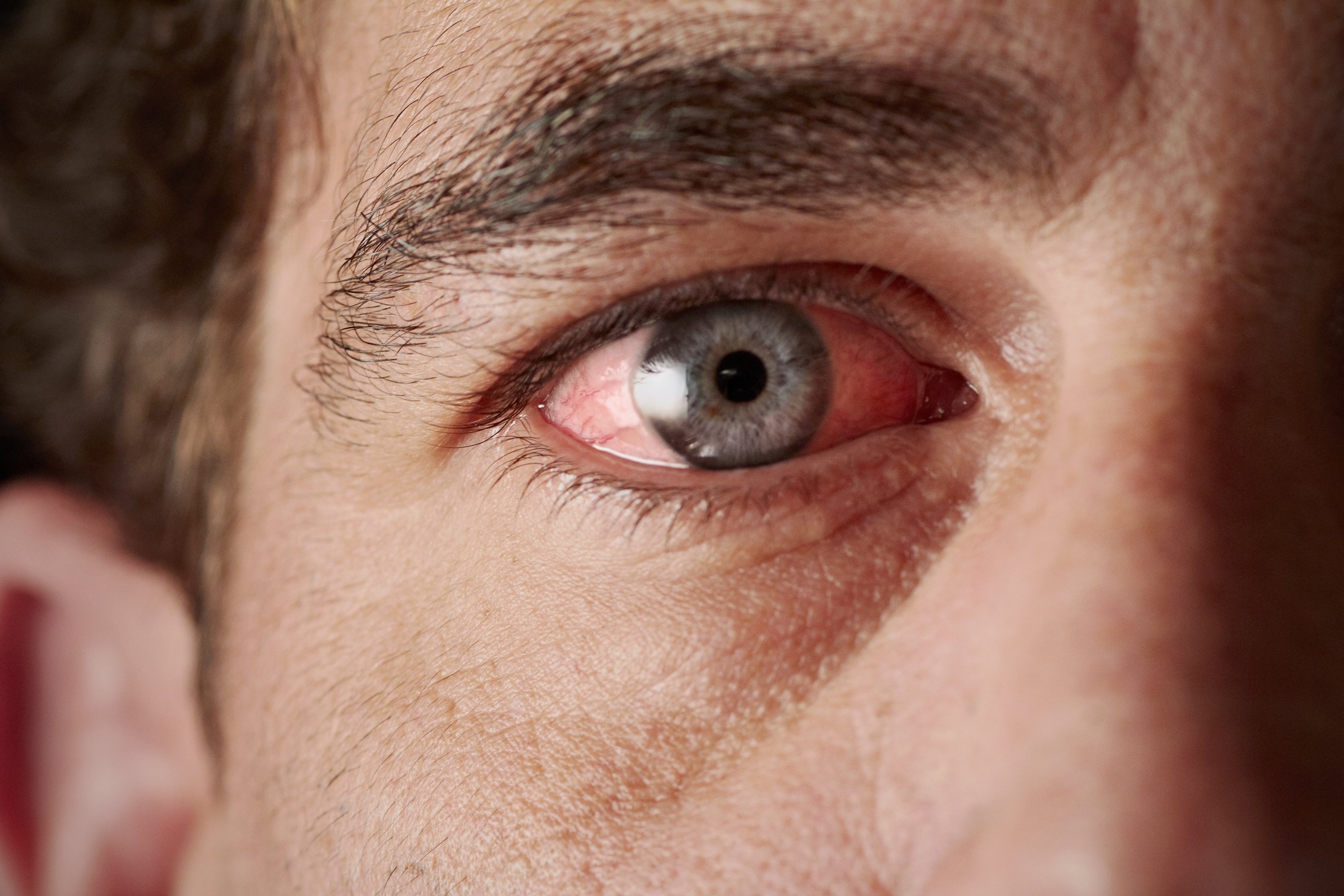WHAT WE TREAT
Pink Eye
Pinkeye — or conjunctivitis — is the inflammation of the thin, transparent membrane that lines the front of the eye.
Commonly caused by viruses, bacteria, irritants, or allergens, this condition can affect one or both eyes.
It is highly contagious when caused by bacteria or viruses, spreading quickly from one eye to the other and from person to person. Despite the discomfort it causes, conjunctivitis usually resolves on its own or after removing the irritant or allergen causing the inflammation.
However, in some cases, an antibiotic may be required to prevent further complications to the eye. Knowing the signs and symptoms of conjunctivitis can help the affected individual pursue appropriate treatment and reduce unintended infectious exposure.

What is Conjunctivitis?
Easily identified by redness in the whites of the eyes, conjunctivitis is more commonly known as pinkeye. It is the inflammation of the conjunctiva -- the thin, transparent membrane that lines the front of the eye. This membrane covers the inside of the eyelid and the white part of the eye, called the sclera. Between the conjunctiva and the sclera are tiny blood vessels, which supply blood and nutrients to the eye.
The conjunctiva normally functions to keep bacteria and foreign material from entering the back of the eye. However, it can become affected by the same particles from which it seeks to protect the eye. These particles can cause inflammation of the conjunctiva and the blood vessels located just beneath the membrane. Inflammation of the blood vessels makes them more visible, resulting in the characteristic redness in the whites of the eye.
Symptoms of Conjunctivitis
Symptoms of conjunctivitis are usually localized to the affected eye(s). They include:
-
Redness in the white of the eye(s)
-
Discharge from the eye(s)
-
Itchy eye(s)
-
Burning eye(s)
-
Increased tearing
-
Blurred vision
-
Photophobia, or increased sensitivity to light
-
Foreign body sensation
The redness of the eye is usually diffuse throughout the whites of the eye. Additional symptoms may arise if the bacteria or virus causing the infectious conjunctivitis spread to other organ systems in the body.
What Causes Conjunctivitis?
Conjunctivitis is most often caused by bacterial or viral infection, but can also be caused by irritants or certain allergens. Infectious conjunctivitis is highly contagious and can spread quickly by direct or indirect contact. Irritant and allergic conjunctivitis are less serious and usually resolve when the cause of the inflammation is removed.
Infectious Conjunctivitis
Infectious conjunctivitis is caused by either a virus (viral conjunctivitis) or bacterium (bacterial conjunctivitis). There are a number of different viruses and bacteria that can infect the conjunctiva. Often times, the infectious agent may also simultaneously affect other organ systems, causing upper respiratory tract infections and/or pharyngitis. A highly contagious condition, infectious conjunctivitis can spread quickly via both direct and indirect contact. Its source is often viral across all age groups. However, bacterial conjunctivitis is more common in children than in adults.
Viral conjunctivitis is typically caused by adenovirus, the source of the common cold. Individuals may present with conjunctivitis alone or as part of a cold, with associated fever, sore throat, runny nose, and swollen lymph nodes. Viral conjunctivitis is characterized by watery, mucoserous discharge from the eye. Individuals with viral conjunctivitis often complain of a feeling of grittiness, burning, or irritation in the affected eye(s). It usually begins in one eye and spreads to the other eye within 24 to 48 hours. Symptoms will typically worsen for the first 3 to 5 days, followed by gradual improvement over a period of 2-4 weeks.
Bacterial conjunctivitis is commonly caused by staphylococcus aureus (staph infection) or streptococcus pneumoniae (strep infection), both of which can cause other conditions in the body such as strep throat and skin infections. Bacterial conjunctivitis is associated with thick, globular discharge from the eye that can be yellow, white, or green in color. This discharge differs from the watery drainage that is characteristic of viral conjunctivitis. Bacterial conjunctivitis typically causes redness and discharge in only one eye and can last as briefly as 2-5 days.
Allergic Conjunctivitis
Conjunctivitis is not always caused by an infection. Inflammation of the conjunctiva can also be caused by an allergic reaction to certain airborne substances. This type of conjunctivitis is known as allergic conjunctivitis. Possible allergens that cause conjunctivitis are:
-
Pollen
-
Dust
-
Mold
-
Dander
When the eye comes into contact with these allergens, the body’s immune system exhibits a hypersensitive response to them. This results in the characteristic redness in the whites of the eye caused by the inflammation of the conjunctiva and blood vessels just beneath the membrane.Allergic conjunctivitis typically presents in both eyes simultaneously with symptomatic redness, watery discharge, and itching. This itching distinguishes allergic conjunctivitis from viral conjunctivitis. Symptoms usually resolve once the allergen has been removed or after treatment with appropriate allergy medications.
Allergic conjunctivitis often occurs seasonally with outdoor allergens, such as pollen, but can also occur year-round if the individual is exposed to indoor allergens, such as dust mites or animal dander. Allergic conjunctivitis is more prevalent among individuals with other allergic conditions such as hay fever, asthma, or eczema.
Irritant Conjunctivitis
Often, certain irritants can cause the conjunctiva to become inflamed, resulting in redness of the sclera with associated discharge from the eye. The irritation can be caused by something as simple as dry eyes or by a foreign body or chemical splash.
While some foreign bodies are spontaneously expelled from the eye, a retained foreign body may require removal by a medical provider. Once the foreign body is removed, the affected eye can remain inflamed and red for up to 24 hours.
Individuals whose eyes are irrigated after a chemical splash may experience symptoms of conjunctivitis. These symptoms are often due to the mechanical irritation of the splash or subsequent irrigation and will typically resolve on their own within 24 hours.
When should I Call a Doctor?
All individuals, children and adults, with signs or symptoms of pinkeye should be evaluated by a medical provider as soon as possible. Early diagnosis and treatment can prevent complications and the spread of infection to others.
Treatment of Conjunctivitis
Treatment of conjunctivitis depends on the cause of the inflammation and should be determined in conjunction with a medical provider. In the meantime, individuals who suspect conjunctivitis can take certain measures upon noticing symptoms. This includes washing the eye with water and a cotton ball or paper towel, which should be disposed of promptly. Contact lens wearers should immediately remove the lenses if redness or irritation of the eye occurs.
Since viral, allergic, and nonspecific conjunctivitis typically resolve on their own, medical providers often advise against treatment for these conditions. The medical provider may elect to simply treat the symptoms of the condition with over-the-counter antihistamines/decongestants and lubricants. These treatments should be used as instructed by a medical provider as they merely treat the symptoms and not the cause of the conjunctivitis.
In contrast, bacterial conjunctivitis may be treated with prescription antibiotic ointments such as erythromycin, bacitracin, and sulfacetamide, or antibiotic eye drops such as trimethoprim-polymyxin B, azithromycin, and fluoroquinolone. Ointments are often preferred over eye drops for children. However, since ointments cause blurred vision for approximately 20 minutes after application, eye drops are typically prescribed for adults who need to read, drive, and perform other tasks after treatment.
Prevention of Conjunctivitis
Individuals with bacterial or viral conjunctivitis should take precautions to prevent the spread of infection to others. First and foremost, contact with the infected eye(s) should be avoided, except to wash the eye(s) several times a day with a cotton ball or paper towel. Individuals with conjunctivitis should wash their hands thoroughly multiple times a day with soap and warm water. If soap and water are not readily available, alcohol-based hand rubs are a viable alternative for disinfection. Eye drops used on the infected eye(s) should not be used in a non-infected eye, whether it is the individual’s own eye or someone else’s. Adults and children with infectious conjunctivitis should not share handkerchiefs, tissues, towels, cosmetics, or bed sheets/pillows with others.
As infectious conjunctivitis is highly contagious, individuals with this conditions should stay home from work or school until there is no longer any discharge from the eye(s). In some schools or daycare centers, 24-hour treatment with eye drops or ointments is required before the child can return to school.
Who is at Risk?
Conjunctivitis can affect all individuals, both children and adults. However, certain people are at greater risk for the condition. Susceptible individuals include newborns, elderly, and those with allergies or a weakened immune system.
People who have recently been exposed to someone with viral or bacterial conjunctivitis are at higher risk of contracting conjunctivitis. Individuals with family members diagnosed with pinkeye should be made aware of the aforementioned preventative measures.
Individuals who wear contact lenses are more susceptible to conjunctivitis. Contact lens wearers with redness and discharge of the eye(s) should immediately discontinue use of the lenses and consult with a medical provider. Once diagnosed with conjunctivitis, treatment for these individuals may differ from that of non-contact lens wearers. For example, fluoroquinolone eye drops are not the first-line drug therapy for routine cases of bacterial conjunctivitis, except in individuals who wear contact lenses. For future prevention of conjunctivitis, further evaluation by the individual’s ophthalmologist (eye specialist) may be required to re-assess the contact lens fit, lens type, or lens hygiene.
Complications
Although all conjunctivitis is characterized by a pink or red eye, not all red or pink eyes are caused by conjunctivitis. There are certain sight-threatening conditions that also cause red or pink eye(s), such as acute angle glaucoma, iritis (inflammation of the iris), and infectious keratitis (inflammation of the cornea). Individuals with red or pink eye should be evaluated by a medical provider to rule out a more serious condition. This is especially critical for contact lens wearers who are more susceptible to sight-threatening complications. Identifying the cause of the redness in the eye may require a full eye examination by a medical provider or further evaluation by an ophthalmologist.
Patients diagnosed with acute bacterial conjunctivitis generally respond to antibiotic treatment within the first couple of days, as evidenced by a decrease in discharge, redness, and irritation. Patients diagnosed with viral, allergic, or nonspecific conjunctivitis commonly exhibit improvement within two weeks. If symptoms worsen or remain unchanged for longer than the specified time periods, despite initial medical evaluation and treatment, a specialist should be consulted. Failure to respond to therapy could indicate dry eye, medicamentosa (drug toxicity), pterygium, blepharoconjunctivitis, and adult inclusion conjunctivitis.
Emergency Warning Signs
Pinkeye in newborn babies should be immediately evaluated by a medical provider as it is a sight-threatening infection at that age.Individuals should seek prompt medical attention if displaying any of the following signs and symptoms:
-
Eye tenderness
-
Vision changes
-
Sensitivity to light
-
Severe headaches with nausea
-
Recent trauma to the eye
-
Use of contact lenses
If this is a medical emergency, please call 911. For mental health emergencies, call 988.
Have a visit today
Virtual care is a convenient and secure way to receive medical care for conditions like conjunctivitis by phone (where permitted) or video, 24/7/365.
